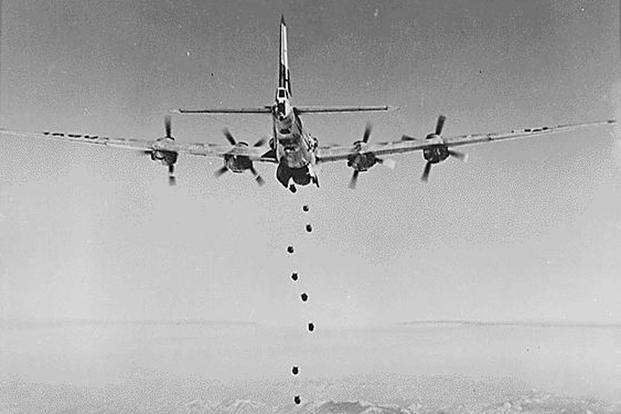The name is Hubert Mark Altvater. I was born on Oct. 23, 1921, in a little town named Winfield, Kansas, about forty miles south of Wichita. When I was 14 years old, my father accepted a position in Greensboro, North Carolina, and that has been my hometown since that time.
I was a junior at the University of Michigan when Pearl Harbor happened. I finished out my semester at Michigan and returned home to Greensboro, because I knew I would be invited to participate in the global conflict that was fast developing.
On April 28, 1942, I took the examinations for aviation cadet, passed them and was sworn into the U.S. Army Air Force. I was classified as a pilot at the classification center in Nashville, Tennessee. I did my pre-flight training at Maxwell Field in Montgomery, Alabama, primary flight training at Avon Park, Florida, basic flight training at Bush Field in Augusta, Georgia, and advanced flight training at Turner Field in Albany, Georgia, where I graduated as a second lieutenant pilot on June 30, 1943.
I was trained in the B-26 Marauder bomber at Barksdale Field in Shreveport, Louisiana, and was sent overseas as a part of a replacement bomber crew in September 1943. I ended up in the 386th Bomb Group in the 554th Bomb Squadron, located at Great Dunmow in Essex County, England, where I began flying combat missions in February 1944. I was later promoted to first lieutenant and checked out as first pilot.
Our normal practice when I first began flying combat was to fly one mission per day for 8-10 days and then have some time off. Our targets were primarily pilotless aircraft launching sites in the _____ peninsula in ____ area, marshaling yards, aircraft installations, bridges, communication and transportation centers, and fuel dumps.
Later, two missions a day became normal routine. Toward the end of May 1944, we began hearing rumors of an impending attack, but we put little credence into these rumors. We simply spent the first few days of June 1944 flying missions. On the night of June 5, 1944, inspecting officers came around to our huts and checked our pistols, ammunition and knives; we were told nothing, except don't plan on much sleep that night. At about 2:30 a.m. on June 6, 1944, we were rousted out of bed and told to dress and go to breakfast and then report to the briefing room ready to fly.
At the briefing, we were told that we would be hitting coastal gun emplacements on the Normandy beaches and that we would complete the mission regardless of cloud cover. At the time, it was pitch dark and raining quite hard, but we were dispatched at the aircraft and lined up for takeoff. None of us was used to flying at night, much less in hard rain and low ceiling. We had to assemble by means of colored flares, and being unable to see any of the hundreds of B-26s in the air at approximately the same altitude was a terrifying experience.
Somehow we got assembled into formation just under the clouds at about 6,000 feet over England. It was my 45th mission. We headed south and soon began to lose altitude in staying under the cloud cover. There were eight combat groups of B-26s involved, and we took it as a signal honor that we were chosen to go in last, just before the troops hit the beach. Our first mission that day was the Utah beach, and we were to bomb the coastal guns at St. Martin ______.
By the time we got to the target and squared away on the bomb run, we were at between 800 and 900 feet altitude. My thought at the time was that they could hit us with slingshots, and we did sustain considerable small arms and machine gun damage. As we approached our bomb run, two German FW-191 aircraft capped off our right wing at our altitude but never came in. They would not have made it. Each plane in our formation dropped two 1,000-pound bombs, and my best recollection of looking at my watch was 6:22 a.m.
After the bomb run, instead of turning left and going back over the Channel, which was packed with assault craft and which would have been our normal path, we turned right and flew over the Cherbourg Peninsula and came back to England from the southwest. Our group flew four missions that day, and I flew the first and third. The third mission was to bomb the coastal guns at ________, which we did.
My particular group sustained damage but no losses that day, and it has always been my feeling that the Germans were so terrified of the sight of so many ships and so many planes that they weren't sure who to shoot at. I continued flying missions after D-Day, and I was shot down on my 63rd mission by German anti-aircraft fire.
I was a prisoner of war of the Germans for about 9½ months at Stalag Luft I in Barth, Germany. We were liberated by the Russians, and it took us about a month, five weeks, to get back to the United States. After that, I was separated from the air force in September of 1945.
After this, I continued my education and graduated in mechanical engineering from North Carolina State University in the class of 1949. I spent 40 years in engineering and I'm now retired. Nothing before or since quite matches the thrill and excitement of that first D-Day mission.
Want to Know More About the Military?
Be sure to get the latest news about the U.S. military, as well as critical info about how to join and all the benefits of service. Subscribe to Military.com and receive customized updates delivered straight to your inbox.















